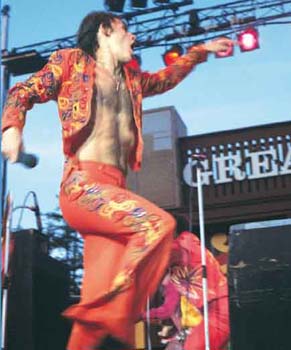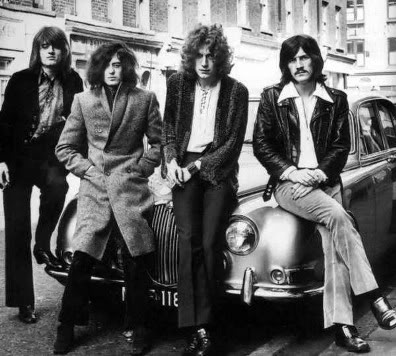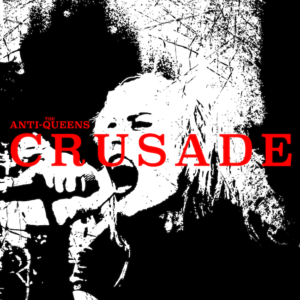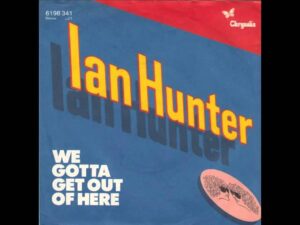By Tom Kipp
“If I had to boil down for a Martian what “it” IS that made rock music the joy of my life, there could be no finer aural aid than this [The Sonics version of “Louie Louie” ] guitar/vocal Tandem Scream from the Id. They say Grunge was “raw”, but it may as well be The Tijuana Brass compared to these two minutes fifty-seven…” – Tom Kipp
A truly brutal exercise—I could easily compile TEN lists like this one in a half hour, with no repetition, and MEAN it. After all, a year ago (and much to my own surprise!) I put together a disturbingly excessive reckoning of my 750 favorite singles, even while permitting but a solitary entry per artiste.
And, at this late juncture, certain of my Absolute Faves now seem—after 30 years of loving them—to have been chiseled into my own “Musical Mount Rushmore”, not just decades but perhaps even a CENTURY ago, in some mythic area of the imagination well beyond the scope of RATIONAL DISCUSSION.
 A few of these would also be among those (Wolf, The Sonics & Flipper, to be precise), but what mostly follows instead are songs about which I happen to have something very personal to SAY.
A few of these would also be among those (Wolf, The Sonics & Flipper, to be precise), but what mostly follows instead are songs about which I happen to have something very personal to SAY.
By the by, I’m delighted that others have already anointed “Gimme Shelter”, “No Fun”, “Diane”, “Like a Hurricane”, “Positively 4th Street”, “Baba O’Riley”, “Roadrunner”, “Theme”, “Ceremony” and “Why You Wanna Treat Me so Bad?” (hey, THAT would make some “Ten Songs”!), which better justifies this conceit and further salves my conscience.
So, consider this A List, rather than The List. Still a good’un though!
And now, the envelope please….
Howlin’ Wolf—“Spoonful” (Chess 1960, 2:45)
The day before I flew home to Montana from Providence (23 May 1982) I found a very useful, cartoon-jacketed, budget-line blues sampler—America’s Musical Roots—that contained many of the most famous singles ever to appear on Chess Records, this one foremost among them.
Nothing about the chundering roar of Cream’s infamous 15-minute live cover version (from 1968’s Wheels of Fire) had prepared me for the dazzling economy of this implacable 3-minute original. The Wolf reaches a peak of gruff soulfulness herein, but the chief attraction for a 19-year-old me, amazingly enough, was one Hubert Sumlin, whose elegantly jagged guitar accompaniment still strikes me as the most tersely perfect single performance I’ve ever heard on my favorite instrument!
In my dreams I can effortlessly reel off riveting 2-, 3- and 4-note runs like these, along with the occasional trademark solo, thereby piercing the eardrums and upsetting the all-too-mellow bodily rhythms of the benighted….as Mr. Sumlin apparently still does, FIFTY years later.

Sometime in the fall of 1981, well before my freshman year at Brown took its big nosedive, I finally had the opportunity to see Mean Streets, the movie that made Marty Scorsese’s rep in 1973. When, near the outset, Harvey Keitel enters a long dark bar where everything important seems to happen, the action suddenly morphs into the dreamiest slow-motion, and from an onscreen jukebox—though with more clarity and punch than any jukebox I’ve ever heard—comes the strains of this spooky, Spector-ish ballad, The Stones’ second US Top 40 hit.
Spare high drama pop yearning, seldom matched by anyone, veiled by threat, anchored by the beat of a struck tambourine (!), though with the effect of a huge snare drum crack. Unquestionably one of my five favorite Stones tracks, out of at least 50 special favorites, and said to be the FIRST song Mick & Keith ever wrote.
The Sonics—“Louie Louie” (Etiquette 1965, 2:57)
The Kinks invented Power Chord Rock in 1964 in the UK, and lo, it was good. We Yanks (via Link Wray’s “Rumble” in 1958) had already provided the world with Distorted Dread Rock, but it remained for this Pacific Northwest teen dance combo to match The Kinks’ achievement Stateside.
As has been endlessly documented by musical “scholar squirrels” (to re-deploy Gore Vidal’s term of caustic affection for academic historians), EVERY self-respecting rock band in the I-5 corridor started playing some variant of Richard Berry’s original, Cuban-inflected “Louie Louie” right around the time “Rumble” hit, with the charmingly inept Kingsmen actually topping the charts in 1963.
 Soon after, President Kennedy was shot and then, if you credit John Waters’ account, The Beatles destroyed rock and roll.
Soon after, President Kennedy was shot and then, if you credit John Waters’ account, The Beatles destroyed rock and roll.
This belated, thoroughly unfashionable blast therefore arrived as “The Last Word in Louies”, a shocking prefigurement of both the late-‘60s Detroit of MC5/Stooges and of late-‘80s Seattle Grunge, tucked away on a b-side, probably because the band hadn’t written it and its management didn’t want to miss out on any possible royalties.
In 1983 Rhino Records released The Best of Louie, Louie, a small first step toward documenting the world’s most popular rock song. Alongside the likes of Black Flag (1st runnerup, all-time!) and the Rice University Marching Band, The Sonics’ version came head of the class, clearly a ground zero for punk, heavy metal (as we once called it) and anti-social teenage BLARE in general.
It also marks the debut of a device of arrangement that, nearly four decades later, I codified as “The Bryan Adams Part”, one of the linchpins of a presentation entitled “Taxonomizing Sludge!” that my old pal Tim Midgett and I gave at EMP’s 2nd Pop Music Conference in 2003.
To wit: At some point, preferably near the climax of a given song, everything drops out, leaving a split second of silence, followed by the unaccompanied, crushing onslaught of distorted guitar chords.
And then, in this case, one of the most throat-shredding screams ever emitted by the human larynx.
If I had to boil down for a Martian what “it” IS that made rock music the joy of my life, there could be no finer aural aid than this guitar/vocal Tandem Scream from the Id. They say Grunge was “raw”, but it may as well be The Tijuana Brass compared to these two minutes fifty-seven.
 Edison Lighthouse—“Love Grows (Where My Rosemary Goes)” (Bell 1970, 2:51)
Edison Lighthouse—“Love Grows (Where My Rosemary Goes)” (Bell 1970, 2:51)
Let’s say you wanted both to usher in the 1970s AND write The Ultimate Bubblegum Smash. First you’d shamelessly pilfer and re-combine only the best aspects of the (suspiciously similar) main hooks from Bo Diddley’s epochal “Road Runner” and Paul McCartney’s “Lady Madonna”, double the resultant megahook with a juicy string arrangement, hire a (now famous) jingle singer named Tony Burrows, and repeat that inanely irresistible chorus FIVE times inside a mere 2:50.
Then, if you were fortunate enough to trap said pop lightning on a vinyl 45 cut by nameless Brit session hacks, you’d top the charts in the UK and reach the Top 5 in the US.
Clearly lacking both the depth of craft and undeniable soul of High Partridge Family or High Cowsills, “Love Grows” permits nothing to get in the way of that steamroller hook, thank Whomever!
A lovely (allegedly improvised) throwaway couplet in the fade provides a perfect epitaph for the song itself: “If you’ve met her/You will never forget her….”!
Not without reason, this immortal trifle is the lead cut of my current “Desert Island Disc”, Rhino’s super-saturated embarrassment of ‘70s riches, the 7cd/160-cut Have a Nice Decade! box set. For the sane and/or budget-minded, it can also be found on Rhino’s marvelous Super Hits of the ’70s: Have a Nice Day, Vol. 2.
 K.C. & the Sunshine Band—“Boogie Shoes” (T.K. 1975, 2:12)
K.C. & the Sunshine Band—“Boogie Shoes” (T.K. 1975, 2:12)
Back in the late-‘70s, in the absurd isolation of North Central Montana, we natives were privileged to have 2 Canadian television stations in our paltry cable system, which augmented 5 others from Great Falls and Spokane, as well as the then-newfangled Atlanta & Chicago “Super Stations”. One of them used to broadcast a cheesily amusing poor man’s after-school version of Solid Gold.
This being 1978, the kids danced to practically nothing but the disco hit parade. One day I happened to hear this ridiculously-catchy South Florida gem, the great K.C. hit that got away, as it were, and even better than their FIVE Billboard #1’s, each of which I also love(d).
It pivots on a hilariously simple bassline, one I now consider (along with that of Talking Heads’ version of “Take Me to the River”) the greatest one to emerge betwixt Sly Stone and PiL! The duh-hey dipshit party lyric (leer-ic?), delivered w/ typically sunny, feathered hair bravado by my 31st January birthday buddy, Harry Wayne Casey, further cements my contention that this cute 2-minute toss-off is The “Louie Louie” of Funk, and just about the cheeriest song in the whole goddamn universe, with deftly-placed horn blasts that more than justify the group’s name!
Cut in 1975, “Boogie Shoes” was only released as a single in some half-assed attempt to cash in on Saturday Night Fever, on whose ubiquitous soundtrack it had bizarrely appeared in late-1977, entombed at the end of the seldom-played side three.
Alex Chilton’s 1980 cover version—half worshipful homage, half who-gives-a-shit desecration—later caused me to conceive the exclusive category “Cover Version Savants”, whose number also include Peter Stampfel, David Johansen, Bryan Ferry, Mark E. Smith, Steve Albini, myself and a few others.
Led Zeppelin—“Bron-Yr- ” (Swan Song 1975, 2:07)
” (Swan Song 1975, 2:07)
The oddest track in The Annals of Zep, and one of the most gorgeous instrumentals I’ve ever encountered. I frequently used to program it along with two other much-loved guitar showcases/anomalies—Jorma Kaukonen’s “Embryonic Journey” and Jeff Beck’s “Greensleeves”—as changes of pace amidst all the riffage, feedback and Beefheart on my teenaged Northern Montana College radio shows of 1979-82 (on KNOG, 90.1 FM, with its “10 blistering watts!”, as my old pal Jay Schuschke once put it).
In terms of Jimmy Page’s accomplishments, I think of it as the ultimate example of “Lyricism & Equilibrium” (a title I gave to one of my favorite compilation tapes 20-odd years ago, on which “B-Y-A” served as a side-opening linchpin) and “Fury Withheld” (yet to be compiled).
Like PiL’s “Radio 4”, it sits there Sphinx-like, beautiful, unreadable, practically inconceivable as part of a great hard rock band’s magnum opus (Physical Graffiti), and an ice-cold drink of pure mountain water amidst the exotic flavors commonly associated with its maker.
Postscript, courtesy of Mark Kozelak/Red House Painters—“So I picked up my brush-painted blue guitar/And I ripped off the chords from ‘Bron-Yr-Aur’….”
 The Sex Pistols—“Satellite” (Virgin 1977, 3:58)
The Sex Pistols—“Satellite” (Virgin 1977, 3:58)
This b-side of “Holidays in the Sun”—a brazen re-write of The Who’s “Substitute”, and as full of gratuitous bile as any Pistols track this side of “Bodies”—is also, thanks to its ludicrous chorus, the one Pistols song I can imagine calling a Love Song, if perhaps the most sarcastic ever played!
In the middle of the night, one lost day in August 1982, my old pal Shawn Swagerty & I attempted to “cover” it for our Havre-era recording project called The Renobs, prompting my bleary-eyed dad to venture down to our family room and inquire just what the hell was going on!
Once we’d turned down a bit, Shawn’s flanger thickened the chords beautifully, but I found that “Satellite” CANNOT BE SUNG except in a Brit accent, thanks to my other 1/31 birthday buddy John Lydon’s indelible voiceprint.
At its climax, as Steve Jones blares away on perhaps the greatest of his (many) faux-Johnny Thunders lead breaks, we find another perfect tag: “I can’t take no more—we’d better stop!”
Pere Ubu—“Over My Head” (Blank/Mercury 1978, 3:55)
A sinister synth squall bleeds into a hushed, bemused David Thomas lullaby (“It’s pretty cute/the way she tucks me in at dawn….”), with the clipped, pseudo-reggae guitar figure the all-too-necessary sonic glue holding these disparate elements together, at least ‘til we reach Tom Herman’s wire walking slide guitar EXPLOSION mid-way, a seeming non sequitur so interstellar-trebly yet precisely right that you’d think it would’ve inspired a thousand copy cats instead of virtually none!
In earliest Ein Heit days, the ‘70s Ubu inspired a hunger for random synth clatter that I was only able to satisfy once my old pal Richard Mockler had bequeathed unto me his seldom-used, monophonic Moog Prodigy in latter 1984!
Joy Division—“Digital” (live) (Factory 1981, 3:15)
Leagues past any of the brilliant studio recordings that made them legends—that stiff, lockstep rhythm, the astringent-plus, edge-of-feedback guitar, the lacerating voice Ian Curtis found for this, his envoi….to JD, to rock and roll, to Life. As my old pal John Kappes wrote, “the live version of “Digital” scours in its intensity.”
There’s a raw, flayed flesh pull to what’s captured on the live portion of Still, especially this, the last song of their final gig. The band lurches to and fro as the singer summons the force that made him “for the ages”, just one more once: “Don’t ever fade away….fade away….fade away….FADE away….FADE AWAY!” Two weeks later he took his leave.
Flipper—“Sex Bomb” (Subterranean 1981, 5:19)
The Greatest 7-Inch Single in Human History (it says here), a masterful assemblage of guffaw-inducing NOISE(S), and the first song I was ever able to figure out how to play on my own!
Odyssey—“Together” (RCA 1982, 6:21)
Easily the most arcane item here, with an anonymous-if-moving vocal and an obsessively minimal lyric, this is one of those organic ACCIDENTS that talented pros create one time in a million, and remains criminally unheard!
Not too long after I arrived in Seattle (July 1992), my dear sister Laurie presented me with a battered 12-inch single rescued from a club DJ pal’s reject pile. The A-side was this moderately obscure disco band’s one actual hit (“Native New Yorker”), which I’d half-liked since its days on Havre, Montana’s AM radio, circa-1978.
At some point, however, I forced myself to play the flip, which I naturally assumed would be tepid, nth-wheel funk of the sub-Dazz Band variety, at best. Instead I heard the heartbeat rhythm of a primitive drum machine, buttressed by an equally spare bassline and the iciest one-finger organ you ever overheard from down a long hallway.
 Turned out “Together” was actually The Great Lost Chic Masterpiece—the bass player turned out to be Bernard Edwards, and the crucially hypnotic guitar was a tossed off bit o’ genius from Nile Rodgers. I played this 6-minute track a half-dozen times in a row, in a haze of disbelief that first day, and I’ve never managed to play it just once in all the intervening years!
Turned out “Together” was actually The Great Lost Chic Masterpiece—the bass player turned out to be Bernard Edwards, and the crucially hypnotic guitar was a tossed off bit o’ genius from Nile Rodgers. I played this 6-minute track a half-dozen times in a row, in a haze of disbelief that first day, and I’ve never managed to play it just once in all the intervening years!
For those curious enough to seek it out, there is a 1994 Collectables label Odyssey compilation called Native New Yorker that features ten of their best, including both 12-inch versions mentioned above. As of today a new copy can be acquired for $9.57 from ImportCDs, via Amazon Marketplace.
The Jesus and Mary Chain—“My Little Underground” (Warner Bros. 1985, 2:32)
The three earliest songs I can recall hearing on the radio date from the five years (Nov 1963-Nov 1968) my family resided at the Agency Headquarters, near Dixon, MT on the Flathead Indian Reservation. One was “A Hard Day’s Night”, and when I purchased Hot Rocks in 1978 I realized another had been “Get Off of My Cloud”.
But it wasn’t until July of 1988—during the first week of my employment at Fairfax, Virginia’s The Record & Tape Exchange—that I discovered what the third had been. When TJAMC’s Psychocandy was belatedly issued in the US in 1986, I spent that entire awful summer fixating on this, my favorite cut, which I felt CERTAIN I recognized as the deft rip-off of some classic pop song of the mid-1960s.
But, try though I did for more than two years, I was never able to figure out which one, much to my dismay & irritation. That day in July, however, I happened to bring home a bargain bin copy of Farewell to the First Golden Era, still the definitive compilation of The Mamas & The Papas, forty years on. As my stylus reached a cut clumsily entitled “I Saw Her Again (Last Night)”, I fell to my bed laughing in amazement and delight. THIS was it, at long last, the ersatz Ur-Source of Jim & William Reid’s Greatest Non-Hit!
It took the entire summer to decipher the “about nothing” lyric, but the pulverizing 2 & ½ minute feedback symphony required no such “translation”, and its ravishing inevitability was merely completed by learning who’d created its sire.
The Feelies—“Slipping (into Something)” (Twin/Tone 1986, 5:57)
The summer of 1986 was undeniably the low point of my life (thus far….he taps his desktop!), but one July night, as I drove home to Northern Virginia from D.C.’s The 9:30 Club (Squirrel Bait & Volcano Suns, if memory serves), passing the Pentagon through a magical shroud of fog on Route 395, I suddenly heard the far-off-sounding intro to this song, the first evidence that there was finally a second Feelies album, about 5 years late.
Across six minutes of build, climax and resolution, intermingled acoustic and electric chords both tersely cool and expansively warm at once, vocals murmured at the very threshold of audibility, one experiences something akin to an organic, kaleidoscopic journey through the ENTIRE Velvet Underground studio catalog (1967-70], that wondrous assemblage of song and arrangement somehow miniaturized, though in no way DIMINISHED, in this, the Velvets homage to end them all, or at least render all the others—no matter how admittedly GREAT—quite superfluous.
The joyful auditory glow which resulted, on what should have been a desultory 3am commute, can still be accessed each time I play this shockingly undervalued song, one which BY ITSELF transforms The Good Earth into the best of four fine Feelies albums, when without it, it would be worst!
 Teenage Fanclub—“Everything Flows” (Matador 1990, 5:16)
Teenage Fanclub—“Everything Flows” (Matador 1990, 5:16)
I once asked Tim Midgett whether he would agree with my assessment, that this seldom-referenced album track, from near the (most?) fabled indie label’s very birth, was in fact THE SINGLE GREATEST item Matador has ever released. His brow knit for a moment or three, then he admitted that, yes, he too would have to say so.
Don’t know how Gerard Cosloy specifically regards his many “offspring”, but I will only add that this is the one chordal drone that gives “What Goes On” a run for its money. It lasts about five actual minutes, but I would just as soon it went on for a year, to borrow Timmy’s brilliant “WGO” formulation!


